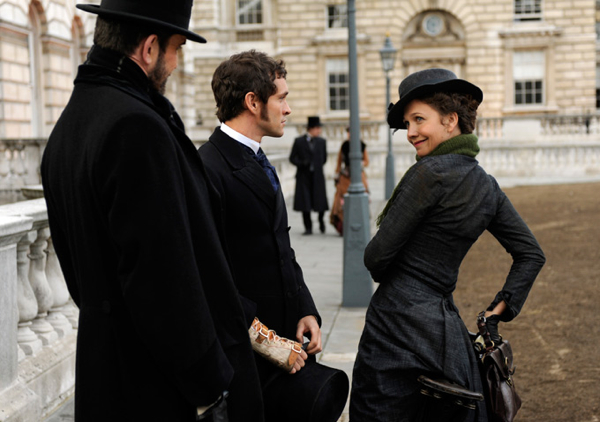Movie review by Greg Carlson
A period comedy riffing on the highly fictionalized origins of the vibrator, “Hysteria” musters a few chuckles at the outrageousness of its subject matter without ever being outrageous itself. Sidestepping any and all opportunity to thoughtfully investigate the gender inequalities of the Victorian age, Tanya Wexler’s movie instead focuses on a lukewarm, screwball-style romance between proto-feminist social crusader Charlotte Dalrymple (Maggie Gyllenhaal) and Mortimer Granville (Hugh Dancy), a young doctor in the employ of Charlotte’s father. Fuzzy, feeble, and flighty, “Hysteria” unfolds like a hastily produced episode of a mediocre television series, providing just enough amusement to prevent one from dozing off.
The matter-of-fact methodology employed by physicians to treat women with symptoms ranging from faintness to insomnia included pelvic massage, and “Hysteria” imagines the examination room of Dr. Robert Dalrymple (Jonathan Pryce) as a comfortable parlor. With a velvet curtain-framed divider providing the necessary level of modesty for the ladies seeking relief, Dalrymple’s practice explodes once word of Granville’s dexterity spreads. In between appointments, Granville sheepishly initiates a courtship with Dalrymple’s demure, beloved daughter Emily (Felicity Jones), even though he cannot seem to keep away from the poverty-stricken settlement house where sister Charlotte volunteers.
The title of the movie obviously refers to the dismayingly common diagnosis applied to women for hundreds of years, but provides little indication that the content will be so chaste. “Granville’s Hammer,” the real-life moniker of the device, is a more evocative name, but would have required a far stronger film. The patients who visit Dalrymple’s office for treatment are grouped together in ridiculous montage sequences that support rather than critique the medical establishment’s infantilizing and condescending attitudes about feminine fragility, and even though one satisfied customer belts an aria in the throes of ecstasy, none of the women emerge as interesting characters.
The notion that male doctors were unable to recognize – or more likely, unwilling to admit – the sexual dimension of one of the most common treatments for hysteria represents another totally missed opportunity for Wexler, and a bummer for anyone expecting more from the capable Pryce. Prevailing attitudes let practitioners off the hook by affirming that female sexual pleasure derived from vaginal intercourse and not external stimulation. Granville’s early success helping patients achieve therapeutic paroxysms quickly gives way to the muscle cramping and pain associated with repetitive strain injuries, setting up the simplified solution courtesy of inventor Edmund St. John-Smythe’s (an underused Rupert Everett) modified electromechanical feather duster.
A movie about the vibrator deserves – pun completely intended – a more stimulating climax than the moth-eaten courtroom testimony chestnut that hinges on Mortimer’s expert opinion in the matter of Charlotte’s mental health. Institutionalization and a forced hysterectomy are only one rap of the gavel away! A friend pointed out that Charlotte could have been committed to an asylum by her father, but that would have negated the suspense-free moment at which our hero delivers his crucial speech. Instead of genuine interest in the exploration of sexual fulfillment, “Hysteria” rushes toward the commonplace conclusion strongly implying that any young woman – even independent firebrands who rebel against the patriarchy – will swoon at a marriage proposal.
